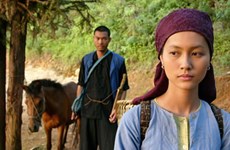Frangipani cultivation booms in Ho Chi Minh City
Colourful frangipani plants placed in pots of various sizes that enchant
so many flower lovers are results of an economic model which has been
in place for almost 10 years by farmers in Hung Long commune, Binh Chanh
district in southern Ho Chi Minh City. Report by the Vietnam Pictorial.
Colourful frangipani plants placed in pots of various sizes that enchant
so many flower lovers are results of an economic model which has been
in place for almost 10 years by farmers in Hung Long commune, Binh Chanh
district in southern Ho Chi Minh City. Report by the Vietnam Pictorial.
The land of Binh Chanh district in Ho Chi Minh City’s outskirts is unfavourable for rice cultivation, as it is waterless in some areas, and flooded in others. Local farmers have for years tried to find other appropriate crops which would bring them a good income, and they include Truong Van Phuong.
During a trip to flower gardens in Sa Dec town of Dong Thap province, Phuong was advised to do the trade by local artisans who are involved in growing ornamental plants, including frangipani, with their high economic value.
Back home, Phuong applied frangipani cultivation in his garden and called other villagers to join him. They established a “Frangipani Club” in Hung Long commune in August 2008.
With only 11 members in the beginning, after seven years the frangipani club has now over 40 members who grow more than 100 species of frangipani on over three hectares of land, of which those species from Thailand are dominant.
Frangipani belongs to the water plant family, with tender branches and suitable for harsh soil and climate conditions. The plant takes little land area and little care of saplings. But the plant grows fast, taking from eight months to one year to bloom flowers which may last for one month.
To create new varieties with diverse colors, farmers used to cut and graft tissues of those which are much sought after by the market, normally those from Thailand.
Grafting techniques are simple and easy to be applied, said club Chairman Truong Van Phuong, who has more than 10 years of experience in growing the plant.
It is easy to grow frangipani as it requires little care, Phuong said. Grafting frangipani should be done on warm sunny days, not on cold or rainy days, as the bad weather may impact the plant’s growth.
Currently, Phuong grows more than 3,000 frangipani plants in his garden of over 3,000 square metres.
According to Ut Anh, an experienced member of the club, whether a plant is much sought after or not depending on the buyer tastes -- its shaping, strange variety, color and even the number of flower petals. But most of them like those of Thailand’s strains.
The club sent its members to Thailand to learn the grafting and tendering techniques, and buy various local strains to grow in Vietnam. After years of hard work, the club’s members have owned many rare varieties of frangipani plants with charming names such as Tan Bach, Thanh Phuong, Baby Girl, Lasting Kiss, etc.
Thanks to its flowers blooming all the year round, frangipani can meet the market’s demand for decoration in urban areas, pagodas, temples, village entrances, private collections of ornamental plants, and particularly at exhibition fairs and holidays.
The club’s products are now available in many localities, including Ho Chi Minh City, southern and central provinces. Each year, it can supply around 50,000 frangipani plants to the market, with each plant costing from a hundred thousand to a million VND. The older the plant is, the more its value will be. Many Club members can earn an annual income of 200 million VND (roughly 9,500 USD).
Frangipani cultivation helped many local farmers not only get rid of poverty, but also become rich.
The club has exported 1,000 Thailand-rooted frangipani plants to Japan, and will export more to other Asian countries in the coming years, said the club’s chairman. He also said that the Ho Chi Minh City’s Farming Consultant Centre has plans to send its engineers to support the club with grafting techniques and care for the plants so as to increase their age, as well as setting up a website to introduce the club’s products to domestic and foreign customers.-VNA
The land of Binh Chanh district in Ho Chi Minh City’s outskirts is unfavourable for rice cultivation, as it is waterless in some areas, and flooded in others. Local farmers have for years tried to find other appropriate crops which would bring them a good income, and they include Truong Van Phuong.
During a trip to flower gardens in Sa Dec town of Dong Thap province, Phuong was advised to do the trade by local artisans who are involved in growing ornamental plants, including frangipani, with their high economic value.
Back home, Phuong applied frangipani cultivation in his garden and called other villagers to join him. They established a “Frangipani Club” in Hung Long commune in August 2008.
With only 11 members in the beginning, after seven years the frangipani club has now over 40 members who grow more than 100 species of frangipani on over three hectares of land, of which those species from Thailand are dominant.
Frangipani belongs to the water plant family, with tender branches and suitable for harsh soil and climate conditions. The plant takes little land area and little care of saplings. But the plant grows fast, taking from eight months to one year to bloom flowers which may last for one month.
To create new varieties with diverse colors, farmers used to cut and graft tissues of those which are much sought after by the market, normally those from Thailand.
Grafting techniques are simple and easy to be applied, said club Chairman Truong Van Phuong, who has more than 10 years of experience in growing the plant.
It is easy to grow frangipani as it requires little care, Phuong said. Grafting frangipani should be done on warm sunny days, not on cold or rainy days, as the bad weather may impact the plant’s growth.
Currently, Phuong grows more than 3,000 frangipani plants in his garden of over 3,000 square metres.
According to Ut Anh, an experienced member of the club, whether a plant is much sought after or not depending on the buyer tastes -- its shaping, strange variety, color and even the number of flower petals. But most of them like those of Thailand’s strains.
The club sent its members to Thailand to learn the grafting and tendering techniques, and buy various local strains to grow in Vietnam. After years of hard work, the club’s members have owned many rare varieties of frangipani plants with charming names such as Tan Bach, Thanh Phuong, Baby Girl, Lasting Kiss, etc.
Thanks to its flowers blooming all the year round, frangipani can meet the market’s demand for decoration in urban areas, pagodas, temples, village entrances, private collections of ornamental plants, and particularly at exhibition fairs and holidays.
The club’s products are now available in many localities, including Ho Chi Minh City, southern and central provinces. Each year, it can supply around 50,000 frangipani plants to the market, with each plant costing from a hundred thousand to a million VND. The older the plant is, the more its value will be. Many Club members can earn an annual income of 200 million VND (roughly 9,500 USD).
Frangipani cultivation helped many local farmers not only get rid of poverty, but also become rich.
The club has exported 1,000 Thailand-rooted frangipani plants to Japan, and will export more to other Asian countries in the coming years, said the club’s chairman. He also said that the Ho Chi Minh City’s Farming Consultant Centre has plans to send its engineers to support the club with grafting techniques and care for the plants so as to increase their age, as well as setting up a website to introduce the club’s products to domestic and foreign customers.-VNA











